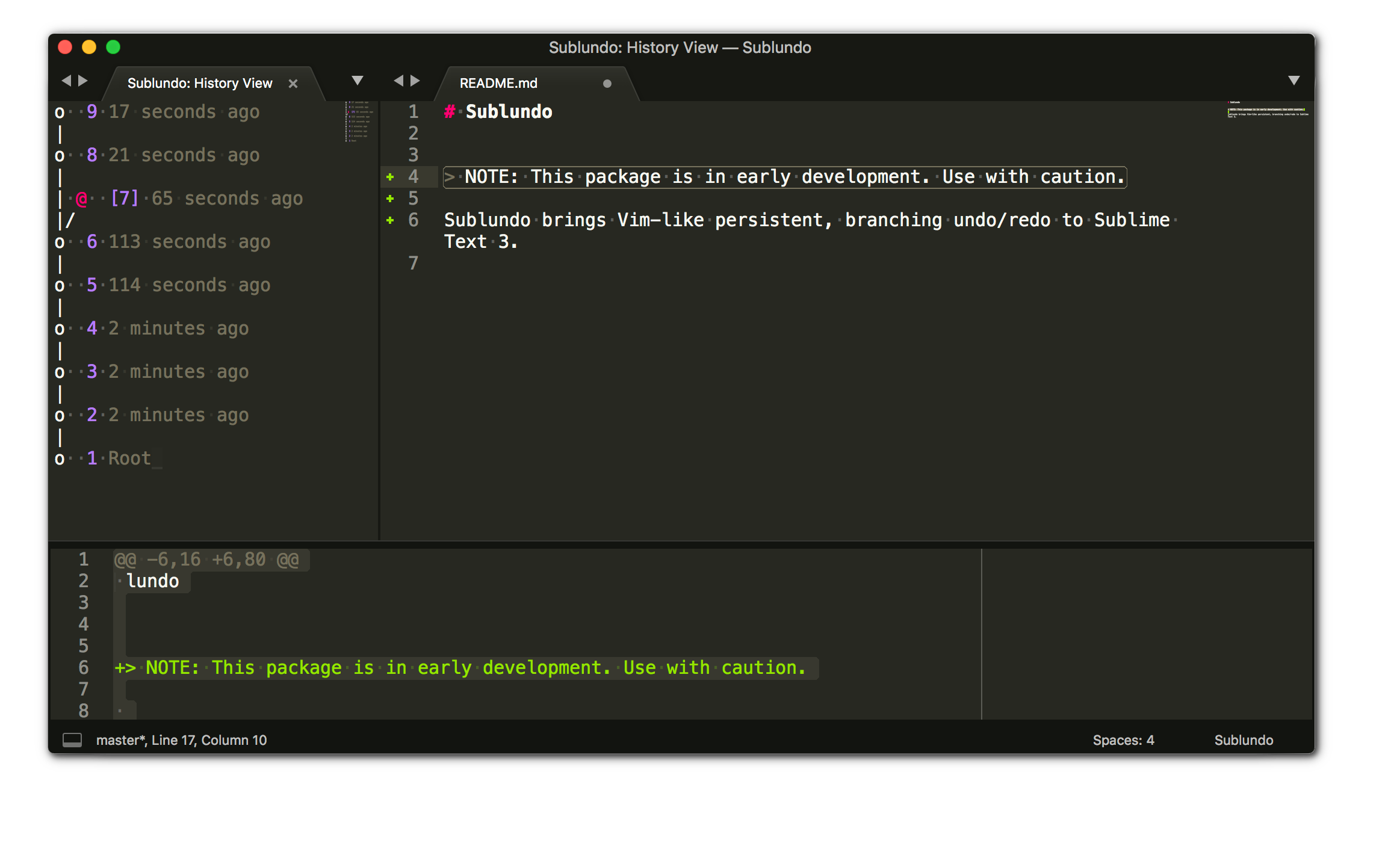Sublundo
A Sublime Text 3 package implementing Vim-like branching undo/redo.
Details
Installs
- Total 544
- Win 220
- Mac 168
- Linux 156
| Dec 26 | Dec 25 | Dec 24 | Dec 23 | Dec 22 | Dec 21 | Dec 20 | Dec 19 | Dec 18 | Dec 17 | Dec 16 | Dec 15 | Dec 14 | Dec 13 | Dec 12 | Dec 11 | Dec 10 | Dec 9 | Dec 8 | Dec 7 | Dec 6 | Dec 5 | Dec 4 | Dec 3 | Dec 2 | Dec 1 | Nov 30 | Nov 29 | Nov 28 | Nov 27 | Nov 26 | Nov 25 | Nov 24 | Nov 23 | Nov 22 | Nov 21 | Nov 20 | Nov 19 | Nov 18 | Nov 17 | Nov 16 | Nov 15 | Nov 14 | Nov 13 | Nov 12 | |
|---|---|---|---|---|---|---|---|---|---|---|---|---|---|---|---|---|---|---|---|---|---|---|---|---|---|---|---|---|---|---|---|---|---|---|---|---|---|---|---|---|---|---|---|---|---|
| Windows | 0 | 0 | 0 | 0 | 0 | 0 | 0 | 0 | 0 | 0 | 0 | 0 | 0 | 0 | 0 | 0 | 0 | 0 | 0 | 0 | 0 | 0 | 1 | 0 | 0 | 0 | 0 | 0 | 0 | 0 | 0 | 0 | 0 | 0 | 0 | 0 | 0 | 0 | 0 | 0 | 0 | 0 | 0 | 0 | 0 |
| Mac | 0 | 0 | 0 | 0 | 0 | 0 | 0 | 0 | 0 | 0 | 0 | 0 | 0 | 0 | 0 | 1 | 0 | 0 | 0 | 0 | 0 | 0 | 0 | 0 | 0 | 0 | 0 | 0 | 0 | 0 | 0 | 0 | 0 | 0 | 0 | 0 | 0 | 1 | 0 | 0 | 0 | 0 | 0 | 0 | 0 |
| Linux | 0 | 0 | 0 | 0 | 0 | 0 | 0 | 0 | 0 | 0 | 0 | 0 | 0 | 1 | 0 | 0 | 0 | 0 | 0 | 0 | 0 | 0 | 0 | 0 | 0 | 0 | 0 | 0 | 0 | 0 | 0 | 0 | 0 | 0 | 0 | 0 | 0 | 0 | 0 | 0 | 0 | 0 | 0 | 0 | 0 |
Readme
- Source
- raw.githubusercontent.com
Sublundo 

Sublundo brings Vim-like persistent, branching undo/redo to Sublime Text 3. It was inspired by Gundo (and its successor, Mundo).
However, since Sublime Text doesn't have native support for branching undo like Vim, we had to build our own data structure—the UndoTree. An UndoTree is an N-ary tree containing nodes that represent a particular buffer state:

Each node contains, among other attributes, a map associating node IDs to patches). This means that, instead of having to store the entire buffer for each insertion (which often consists of small changes), we only need to store the information necessary to travel back and forth (in both the parent → children and child → parent directions). For example: if A = 'Hello, world!' and B = 'Bye, world!', the A → B translation would be [(-1, 'H'), (1, 'By'), (0, 'e'), (-1, 'llo'), (0, ', wo')]. In Python terms, we'd have:
>>> t = UndoTree()
>>> t.insert('Hello, world!')
>>> t.insert('Bye, world!')
>>> t.text()
'Bye, world!'
>>> t.undo()
# (buffer, patch, cursor position)
('Hello, world!', '@@ -1,7 +1,9 @@\n+H\n-By\n e\n+llo\n , wo\n', None)
>>> t.text()
'Hello, world!'
Installation
- Install Package Control.
- Bring up the Command Palette (Command-Shift-P on macOS and Ctrl-Shift-P on Linux/Windows).
- Select
Package Control: Install Packageand then selectSublundowhen the list appears.
Usage
This package completely overrides the built-in undo and redo commands: whenever you undo or redo an edit, the sublundo command is run instead. So, you should be able to edit, undo, and redo text as you normally would.
When you want to either visualize or navigate the UndoTree, you invoke the Sublundo: Visualize command and then use the following keys to move around:
- up (or k): Move up the current branch (i.e., invoke
redo). - down (or j): Move down the current branch (i.e., invoke
undo). - left (or h): Move to the next branch on the left.
- right (or l): Move to the next branch on the right.
For information on the available settings, see the default settings file.
